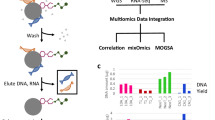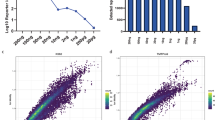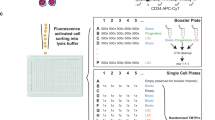Abstract
An approach to the systematic identification and quantification of the proteins contained in the microsomal fraction of cells is described. It consists of three steps: (1) preparation of microsomal fractions from cells or tissues representing different states; (2) covalent tagging of the proteins with isotope-coded affinity tag (ICAT) reagents followed by proteolysis of the combined labeled protein samples; and (3) isolation, identification, and quantification of the tagged peptides by multidimensional chromatography, automated tandem mass spectrometry, and computational analysis of the obtained data. The method was used to identify and determine the ratios of abundance of each of 491 proteins contained in the microsomal fractions of naïve and in vitro– differentiated human myeloid leukemia (HL-60) cells. The method and the new software tools to support it are well suited to the large-scale, quantitative analysis of membrane proteins and other classes of proteins that have been refractory to standard proteomics technology.
This is a preview of subscription content, access via your institution
Access options
Subscribe to this journal
Receive 12 print issues and online access
$209.00 per year
only $17.42 per issue
Buy this article
- Purchase on Springer Link
- Instant access to full article PDF
Prices may be subject to local taxes which are calculated during checkout





Similar content being viewed by others
References
Oseroff, A.R., Robbins, P.W. & Burger, M.M. Cell surface membrane: biochemical aspects and biophysical probes. Annual Rev. Biochem. 42, 647–682 (1973).
Liu, E. et al. The HER2 (c-erbB-2) oncogene is frequently amplified in in situ carcinomas of the breast. Oncogene 7, 1027–1032 (1992).
Shak, S. Overview of the trastuzumab (Herceptin) anti-HER2 monoclonal antibody clinical program in HER2-overexpressing metastatic breast cancer. Herceptin Multinational Investigator Study Group. Semin. Oncol. 26, 71–77 (1999).
Eccles, S.A. Monoclonal antibodies targeting cancer: “magic bullets” or just the trigger? Breast Cancer Res. 3, 86–90 (2001).
Drews, J. Research and development. Basic science and pharmaceutical innovation. Nat. Biotechnol. 17, 406–408 (1999).
Aebersold, R. & Goodlett, D.R. Mass spectrometry in proteomics. Chem. Rev. 101, 269–295 (2001).
Molloy, M.P. et al. Extraction of membrane proteins by differential solubilization for separation using two-dimensional gel electrophoresis. Electrophoresis 19, 837–844 (1998).
Molloy, M.P. et al. Proteomic analysis of the Escherichia coli outer membrane. Eur. J. Biochem. 267, 2871–2881 (2000).
Santoni, V., Molloy, M. & Rabilloud, T. Membrane proteins and proteomics: un amour impossible? Electrophoresis 21, 1054–1070 (2000).
Rabilloud, T. et al. Analysis of membrane proteins by two-dimensional electrophoresis: comparison of the proteins extracted from normal or Plasmodium falciparum-infected erythrocyte ghosts. Electrophoresis 20, 3603–3610 (1999).
Santoni, V. et al. Large scale characterization of plant plasma membrane proteins. Biochimie 81, 655–661 (1999).
Simpson, R.J. et al. Proteomic analysis of the human colon carcinoma cell line (LIM 1215): development of a membrane protein database. Electrophoresis 21, 1707–1732 (2000).
Birnie, G.D. The HL60 cell line: a model system for studying human myeloid cell differentiation. Br. J. Cancer Suppl. 9, 41–45 (1988).
Walter, P. & Blobel, G. Preparation of microsomal membranes for cotranslational protein translocation. Methods Enzymol. 96, 84–93 (1983).
Gygi, S.P. et al. Quantitative analysis of complex protein mixtures using isotope-coded affinity tags. Nat. Biotechnol. 17, 994–999 (1999).
Eng, J., McCormack, A.L. & Yates, J.R. An approach to correlate tandem mass spectral data of peptides with amino acid sequences in a protein database. J. Am. Soc. Mass. Spectrom. 5, 976–989 (1994).
Link, A.J. et al. Direct analysis of protein complexes using mass spectrometry. Nat. Biotechnol. 17, 676–682 (1999).
Zhou, H., Watts, J.D. & Aebersold, R. A systematic approach to the analysis of protein phosphorylation. Nat. Biotechnol. 19, 375–378 (2001).
Stamellos, K.D. et al. Subcellular localization of squalene synthase in rat hepatic cells. Biochemical and immunochemical evidence. J. Biol. Chem. 268, 12825–12836 (1993).
Szkopinska, A., Swiezewska, E. & Karst, F. The regulation of activity of main mevalonic acid pathway enzymes: farnesyl diphosphate synthase, 3-hydroxy-3-methylglutaryl-CoA reductase, and squalene synthase in yeast Saccharomyces cerevisiae. Biochem. Biophys. Res. Commun. 267, 473–477 (2000).
Goldstein, J.L. & Brown, M.S. Regulation of the mevalonate pathway. Nature 343, 425–430 (1990).
Tansey, T.R. & Shechter, I. Squalene synthase: structure and regulation. Prog. Nucleic Acid Res. Mol. Biol. 65, 157–195 (2000).
Gu, P., Ishii, Y., Spencer, T.A. & Shechter, I. Function–structure studies and identification of three enzyme domains involved in the catalytic activity in rat hepatic squalene synthase. J. Biol. Chem. 273, 12515–12525 (1998).
Chen, H.T., Mehan, R.S., Gupta, S.D., Goldberg, I. & Shechter, I. Involvement of farnesyl protein transferase (FPTase) in Fc epsilonRI-induced activation of RBL-2H3 mast cells. Arch. Biochem. Biophys. 364, 203–208 (1999).
Yokoyama, K., Goodwin, G.W., Ghomashchi, F., Glomset, J. & Gelb, M.H. Protein prenyltransferases. Biochem. Soc. Trans. 20, 489–494 (1992).
Shechter, I. et al. Solubilization, purification, and characterization of a truncated form of rat hepatic squalene synthetase. J. Biol. Chem. 267, 8628–8635 (1992).
Memon R.A. et al. Endotoxin, tumor necrosis factor, and interleukin-1 decrease hepatic squalene synthase activity, protein, and mRNA levels in Syrian hamsters. J. Lipid Res. 38, 1620–1691 (1997).
Kiss, Z., Deli, E. & Kuo, J.F. Temporal changes in intracellular distribution of protein kinase C during differentiation of human leukemia KL60 cells induced by phorbol ester. FEBS Lett. 231, 41–46 (1988).
Seibenhener, M.L. & Wooten, M.W. Heterogeneity of protein kinase C isoform expression in chemically induced HL60 cells. Exp. Cell. Res. 207, 183–188 (1993).
Wooten, M.W., Seibenhener, M.L. & Soh, Y. Expression of protein kinase C isoforms in HL60 and phorbol ester resistant HL525 cells. Cytobios. 76, 19–29 (1993).
Ohguchi, K., Banno, Y., Nakashima, S. & Nozawa, Y. Activation of membrane-bound phospholipase D by protein kinase C in HL60 cells: synergistic action of a small GTP-binding protein RhoA. Biochem. Biophys. Res. Commun. 211, 306–311 (1995).
Aebersold, R., Hood, L.E. & Watts, J.D. Equipping scientists for the new biology. Nat. Biotechnol. 8, 359 (2000).
Diehn, M., Eisen, M.B., Botstein, D. & Brown, P.O. Large-scale identification of secreted and membrane-associated gene products using DNA microarrays. Nat. Genet. 25, 58–62 (2000).
Gygi, S.P., Corthals, G.L., Zhang, Y., Rochon, Y. & Aebersold, R. Evaluation of two-dimensional gel electrophoresis-based proteome analysis technology. Proc. Natl. Acad. Sci. USA 97, 9390–9395 (2000).
Acknowledgements
We thank John Glomset, Julian Watts, Steve Gygi, and Beate Rist for helpful discussion and Julian Watts for critical reading of the manuscript. The work was supported by a grant from the University of Washington Royalty Research Fund, a grant from the Merck Genome Research Institute, grant no. 1R33CA84698 from the National Cancer Institute, and grant no. HL67569 from the National Institutes of Health.
Author information
Authors and Affiliations
Corresponding author
Supplementary information
Rights and permissions
About this article
Cite this article
Han, D., Eng, J., Zhou, H. et al. Quantitative profiling of differentiation-induced microsomal proteins using isotope-coded affinity tags and mass spectrometry. Nat Biotechnol 19, 946–951 (2001). https://doi.org/10.1038/nbt1001-946
Received:
Accepted:
Issue Date:
DOI: https://doi.org/10.1038/nbt1001-946
This article is cited by
-
PRAMEL7 and CUL2 decrease NuRD stability to establish ground-state pluripotency
EMBO Reports (2024)
-
Maximized quantitative phosphoproteomics allows high confidence dissection of the DNA damage signaling network
Scientific Reports (2020)
-
Efficient profiling of detergent-assisted membrane proteome in cyanobacteria
Journal of Applied Phycology (2020)



